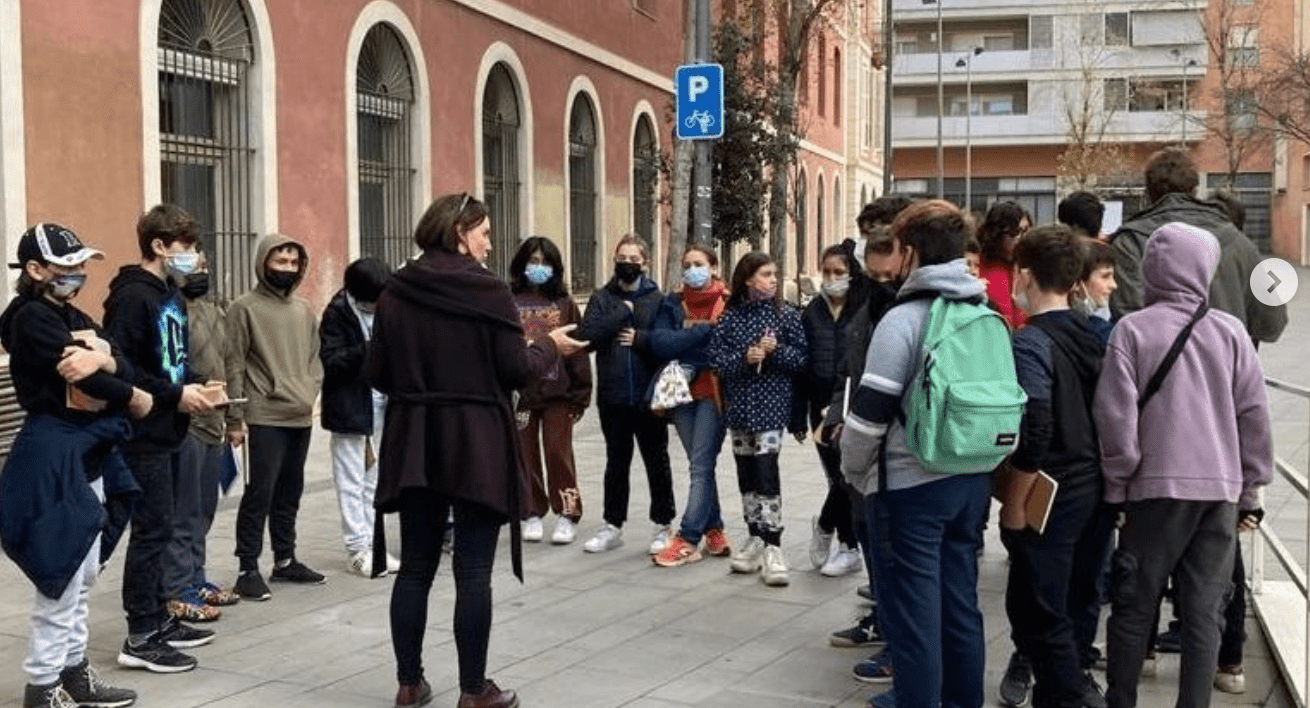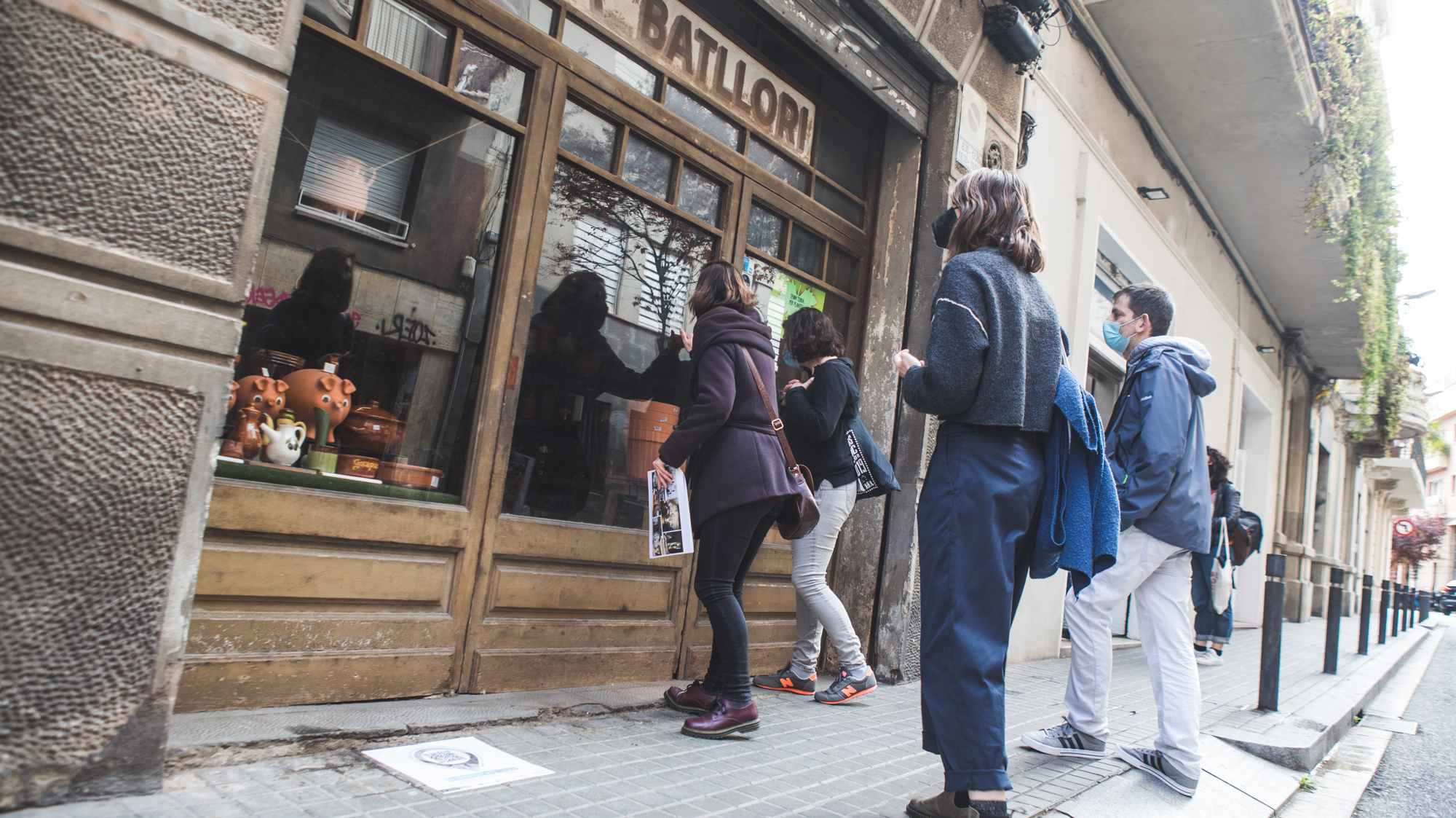Discover the history behind ten emblematic locations in Sants and Les Corts through the eyes of ten artists in this online exhibition navigated through QR codes that you will find in the places marked on this map.
In addition, each month, for a few days only, a site-specific artwork will be installed in one of the locations, creating interpretation layers of historical memory. Visit the online route and don’t miss the onsite exhibitions! They will be announced here.
Navigate through the online exhibition by following this link to the Fundació Suñol website. This project formed part of their “Shortcut” art program
Curatorial Context
As art historian T.J. Clark states, “it takes more than seeing to make things visible”. John Berger, renowned English art critic, novelist, painter and poet asserts that what we see depends on when we see it, and how we see it (Ways of Seeing, 1972)
In this intangible exhibition, you are invited to explore and reflect on the history of various emblematic places in the neighborhoods of Sants and les Corts using subjective perspective as a way of seeing. This is an invisible exhibition which is navigated via mobile phones through QR codes presented on site. In each case, the history of the locality is explained and an artistic work is created specifically for the place where it is presented, thus creating layers of interpretations of historical memory.
Observe how artists with the calibre of Sergi Aguilar (Barcelona, 1946), Ely Daou (Beirut, 1986), Logan B. Fields (United States, 1996), Teresa Gancedo (León, 1937), Marc Larré (Barcelona, 1978), Rebecca Lyne (Cambridgeshire, 1974), Josep Miracle (Barcelona, 1904), Lizette Nin (Domenican Republic, 1984) and Rubén Verdú (Caracas, 1962) create artworks that dialogue in a site-specific conversation across existing dimensions of space and time.
It is of interest to note that in keeping with the subject of multiple perspectives, this exhibition has been conceived and processed in English, Catalan and Spanish, and thus no visitor will see the entire project in its original language.
Artworks
Sergi Aguilar | Ely Daou | Logan B. Fields | Teresa Gancedo | Marc Larré | Rebecca Lyne | Josep Miracle | Lizette Nin | Rubén Verdú










A plan with many routes
There are various themes that tie the locations and artworks to each other.
If one were to organise a route according to chronological order, the itinerary would start with Casa Batllori, in the old quarter of Sants, founded in 1792 – the same year the guillotine was invented and the First French Republic was proclaimed. After visiting this emblematic clay workshop and viewing the collaborative work by Marc Larré and Andreu Battlori, one could visit the Vapor Vell (1848) and contemplate Rubén Verdú’s Bullet Flower before scanning for traces of ghosts on the grounds of cal Nicasi (1870) in an action performed by Logan B. Fields.
Just a few meters away, one could sit on a bench in the park of can Mantega and listen to Josep Miracle’s description of the fields that previously swayed in the wind of this fertile ground, and upon exiting, discover Lizette Nin’s tree installations that interpret the lives of the people whom the surrounding street names are dedicated to.
Crossing the road from can Mantega, one could peep inside the old factory currently housing Flowers by Bornay and discover Rebecca Lyne’s portrait of Justa Goicoechea who worked here in the turbulent years leading to the Spanish Civil War. A few steps away, with the help of Ely Daou, imagine what it was like to be in the underground shelter hereunder, excavated by the neighbouring elderly, women and children to protect themselves during the war. At the end of the war, in 1939, many who had hidden now had to flee from Spain, thus becoming refugees. Perhaps, if they were lucky, instead of giving birth in the horrific conditions of the French refugee camps, a few lucky women would birth in Elisabeth Eidenbenz’s maternity home in Elne.
The road dedicated to Eidenbenz is adjacent to the jardins de la Maternitat (1889). Walking inside these public gardens, one could marvel at the handsome pavilions and interact with Sergi Aguilar’s Inner limit, open book on the turf of the gardens overlooking the Diputation’s archives and from there, perhaps look out to the road named after José Mejía Lequerica and identify the gallery housing the Fundació Suñol which contains the artwork by Teresa Gancedo, hence concluding the walking route and exhibition.
Curatorial Confabulations
In The Work of Art in the Age of Mechanical Reproduction (1935) Walter Benjamin states that mechanical reproduction devalues the aura (uniqueness) of an objet d’art. In conversation with this statement I wonder: how does this relate when the artwork, be it a painting, sculpture or installation conceived as an object or action is specifically created to be photographed and represented on a mobile phone, or displayed on a website?
In Illuminations (1968), he declares that “even the most perfect reproduction of a work of art is lacking in one element: its presence in time and space, its unique existence at the place where it happens to be.” Again confounded on how this relates to this art project, I question: what is more true, a reproduction of an artwork specifically created to be viewed on screen connecting to the location it was originally intended to be experienced, or does its aura remain more intact when presented as the art object itself manipulated by the artist in a gallery?
A plural perspective
It Started with Water is a collection of stories with oficial sources, such as the district archive, historians, journalists, etc, but also stories that were told directly to me by the descendants of those who marked the identity of our neighborhood – they are stories that have often been lost in the passage of time.
Why did It Start with Water?
This narrative begins in 1819 with the inauguration of the Canal de la Infanta, which carried fresh water from the Llobregat river to the independent town of Sants. The canal was built for purely agricultural purposes, with the aim of transforming the fertile lands of this area into irrigated land, thus increasing productivity, expanding the variety of crops and reducing production costs.
This initial goal was quickly achieved and far exceeded the expectations of its promoters. At the same time, the canal brought an unforeseen benefit to this neighborhood: the industrialization of this land.



